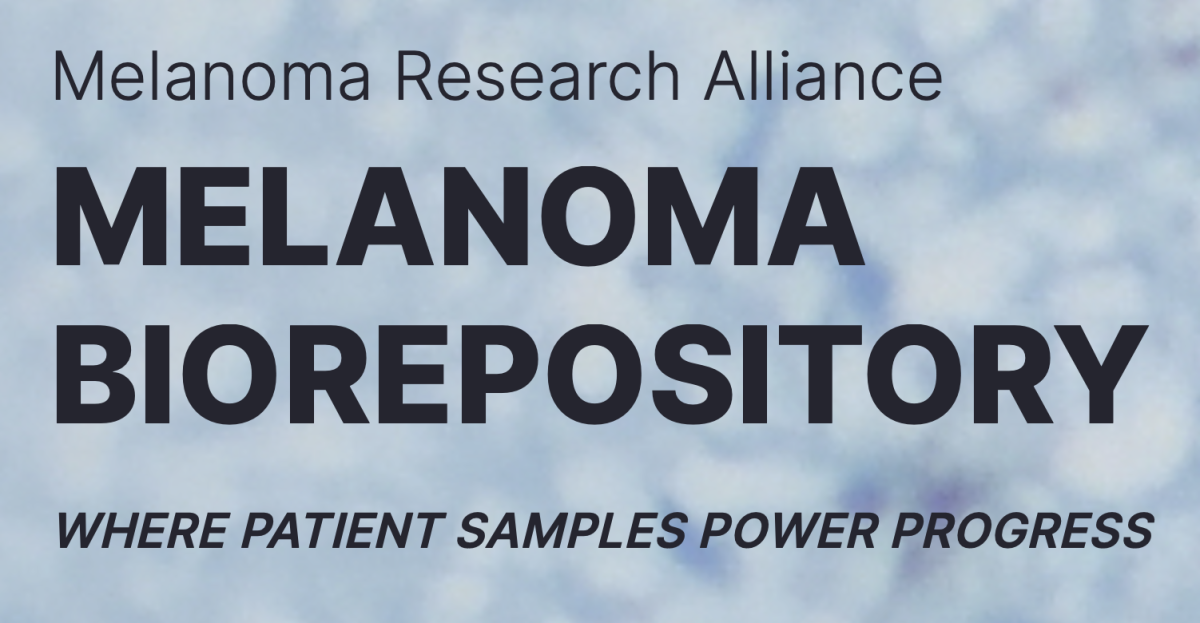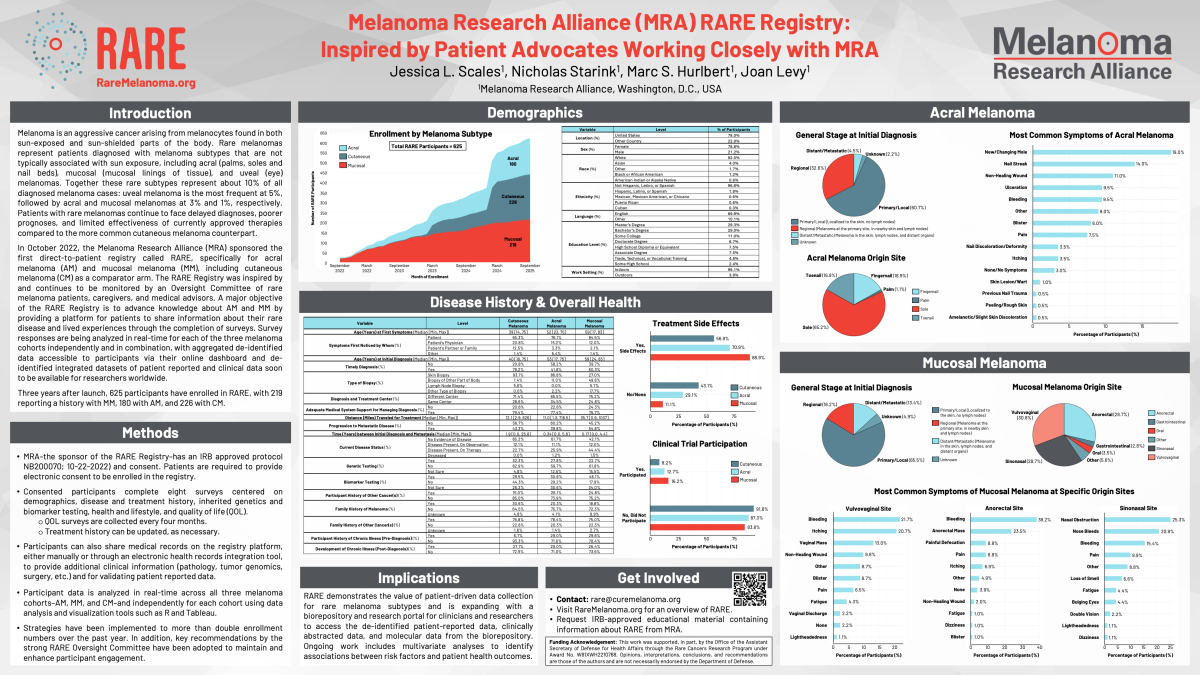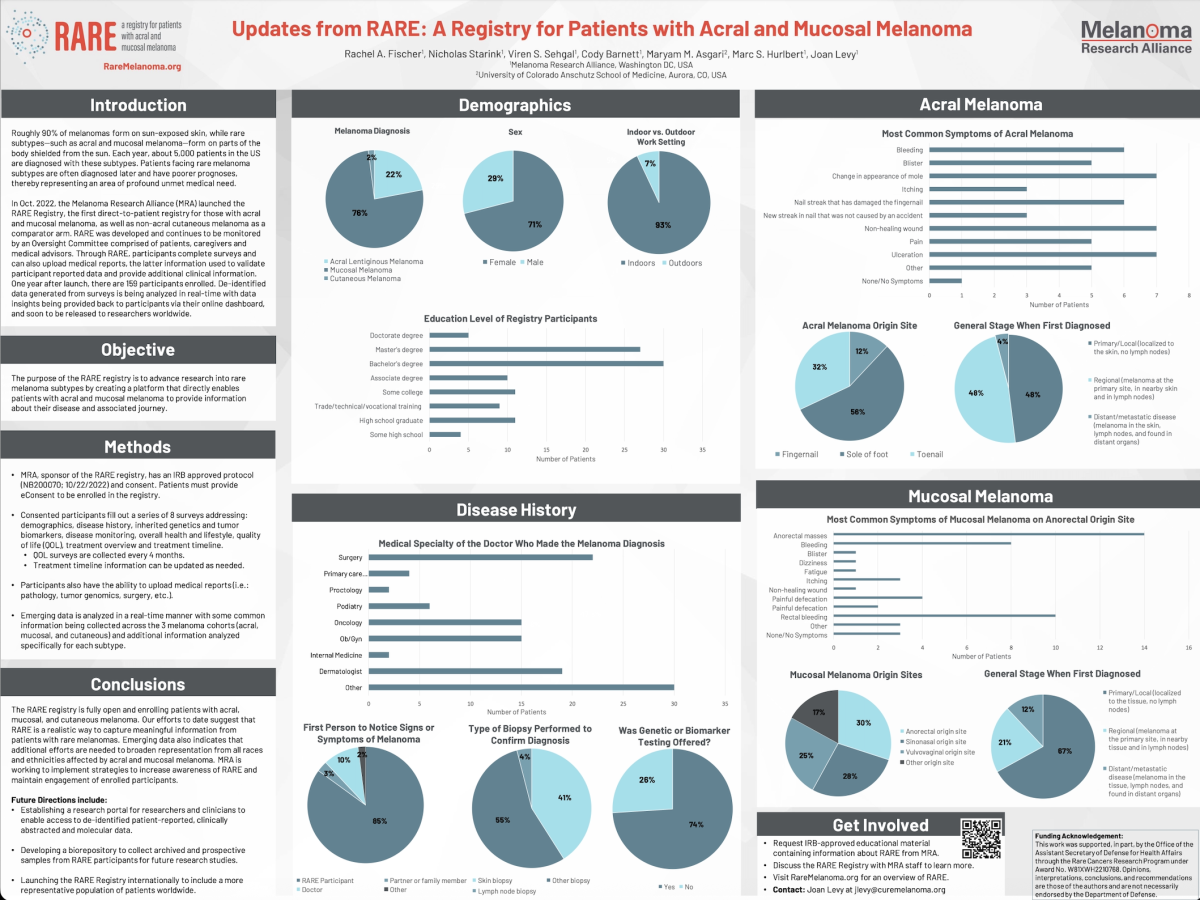Rare Registry Updates
-
Posted: 2025-12-03Updated: 2025-12-03
 The Melanoma Research Alliance (MRA) is excited to announce the launch of a Melanoma Biorepository, a new initiative poised to accelerate melanoma research and improve health outcomes for patients with melanoma. Participants enrolled in the RARE Registry can now choose to donate tumor and normal tissue samples to the MRA Melanoma Biorepository.
The Melanoma Research Alliance (MRA) is excited to announce the launch of a Melanoma Biorepository, a new initiative poised to accelerate melanoma research and improve health outcomes for patients with melanoma. Participants enrolled in the RARE Registry can now choose to donate tumor and normal tissue samples to the MRA Melanoma Biorepository. -
Posted: 2025-12-03Updated: 2025-12-03
 The MRA highlighted new work on the RARE Registry in a poster presented called, MRA RARE Registry: Inspired by Patient Advocates Working Closely with MRA, which was presented at the 13th Annual JADPRO Live Conference—the annual meeting for the Advanced Practitioner Society for Hematology and Oncology (APSHO). APSHO’s mission is to improve outcomes and quality of life for patients with cancer by championing a team-based approach to cancer care.
The MRA highlighted new work on the RARE Registry in a poster presented called, MRA RARE Registry: Inspired by Patient Advocates Working Closely with MRA, which was presented at the 13th Annual JADPRO Live Conference—the annual meeting for the Advanced Practitioner Society for Hematology and Oncology (APSHO). APSHO’s mission is to improve outcomes and quality of life for patients with cancer by championing a team-based approach to cancer care. -
Posted: 2025-08-14Updated: 2025-12-03
 This collection of scientific updates, originally featured on the Melanoma Research Alliance’s main blog, offers a snapshot of the latest progress in melanoma research. Over the past year, researchers have made important strides in understanding and targeting acral, mucosal, and cutaneous subtypes. These highlights reflect the growing momentum in the field and MRA’s ongoing commitment to advancing research and collaboration.
This collection of scientific updates, originally featured on the Melanoma Research Alliance’s main blog, offers a snapshot of the latest progress in melanoma research. Over the past year, researchers have made important strides in understanding and targeting acral, mucosal, and cutaneous subtypes. These highlights reflect the growing momentum in the field and MRA’s ongoing commitment to advancing research and collaboration. -
Posted: 2023-12-20Updated: 2023-12-20
Tumor infiltrating lymphocyte (TIL) therapy, first pioneered by Dr. Stephen Rosenberg from the National Cancer Institute, isolates immune cells called lymphocytes from a patient’s surgically removed tumor that are then grown in large quantities in the lab. The army of grown TILs are then reinfused back into the patient where they recognize and destroy cancer cells in the body. On March 24th, 2023, Iovance submitted a Biologics License Application (BLA) to the FDA for the approval of Lifileucel. The FDA decision is expected by the end of February 2024.
-
Posted: 2023-11-16Updated: 2025-12-03
 The Melanoma Research Alliance is excited to share a poster presentation called RARE: A Registry for Patients with Acral and Mucosal Melanoma which was presented last week at the Society for Melanoma Research (SMR)’s 20th annual Congress. SMR aims to enhance communication among melanoma researchers by organizing annual research congresses and works to emphasiz new research results to engage basic and clinical researchers.
The Melanoma Research Alliance is excited to share a poster presentation called RARE: A Registry for Patients with Acral and Mucosal Melanoma which was presented last week at the Society for Melanoma Research (SMR)’s 20th annual Congress. SMR aims to enhance communication among melanoma researchers by organizing annual research congresses and works to emphasiz new research results to engage basic and clinical researchers. -
Posted: 2023-08-17Updated: 2025-12-04
 Join the RARE Registry team on August 23 at 12:30 pm ET to hear updates on data from the first 100 participants of RARE! During this special webinar, you’ll meet the RARE Registry staff and some of the RARE patient advisors, learn about some of the exciting data collected so far, and hear about new features available to RARE participants.
Join the RARE Registry team on August 23 at 12:30 pm ET to hear updates on data from the first 100 participants of RARE! During this special webinar, you’ll meet the RARE Registry staff and some of the RARE patient advisors, learn about some of the exciting data collected so far, and hear about new features available to RARE participants. -
Posted: 2022-09-22Updated: 2025-12-03
 Despite the tremendous progress in treating melanoma, approximately one third of patients don’t benefit from currently approved therapies. This includes the majority of people with rare forms of melanoma — melanomas that develop in the eye, nailbeds, palms, soles of the feet, and various mucosal membranes. Patients facing these subtypes tend not to respond as well to current treatments as patients with cutaneous melanomas that arise on sun-exposed skin. But as investigators continue to chip away at understanding what causes these melanomas and how they differ from UV-driven cutaneous melanomas, the hope is the better understanding they reap will be sown into improved treatments for these patients.
Despite the tremendous progress in treating melanoma, approximately one third of patients don’t benefit from currently approved therapies. This includes the majority of people with rare forms of melanoma — melanomas that develop in the eye, nailbeds, palms, soles of the feet, and various mucosal membranes. Patients facing these subtypes tend not to respond as well to current treatments as patients with cutaneous melanomas that arise on sun-exposed skin. But as investigators continue to chip away at understanding what causes these melanomas and how they differ from UV-driven cutaneous melanomas, the hope is the better understanding they reap will be sown into improved treatments for these patients.
